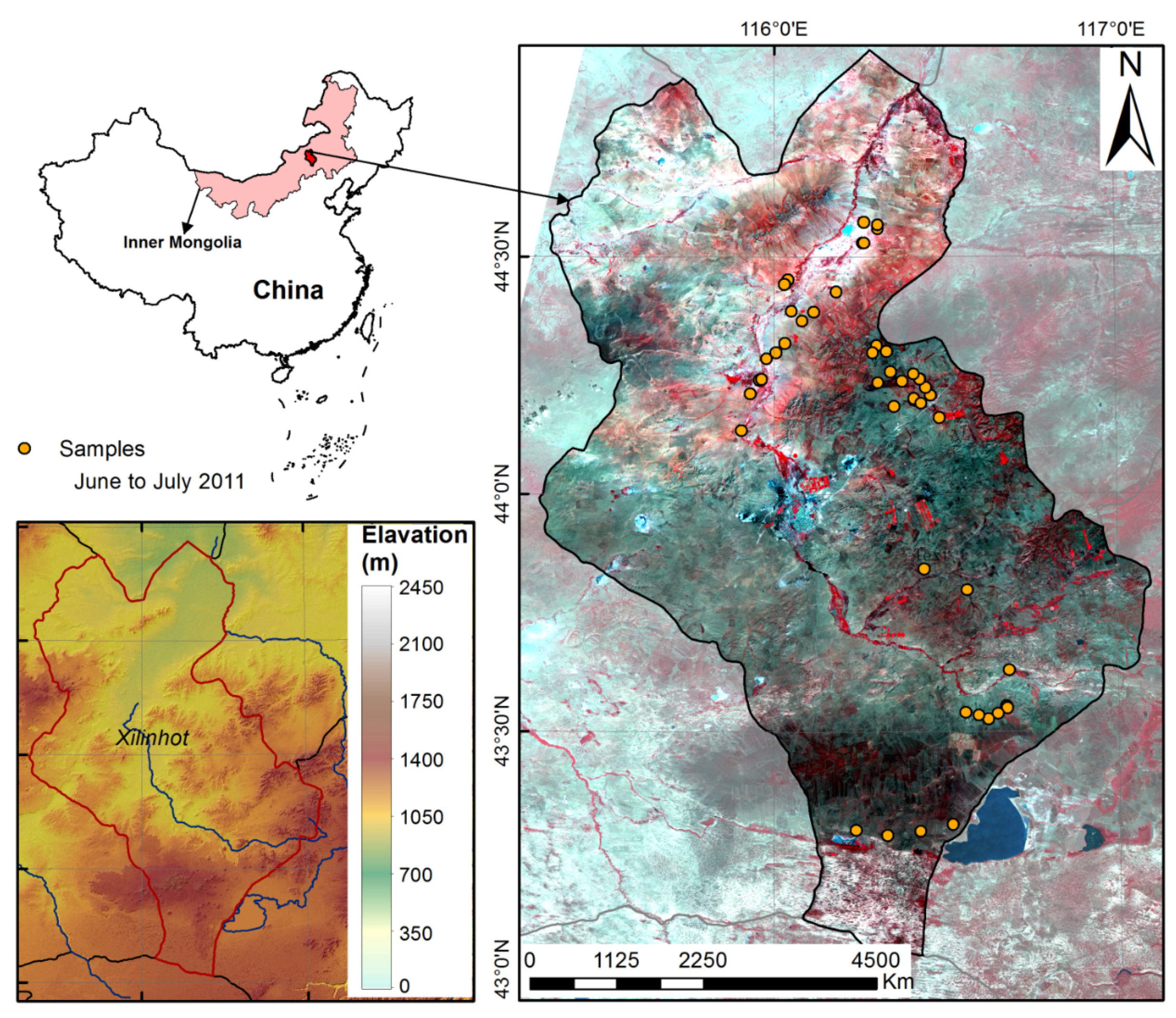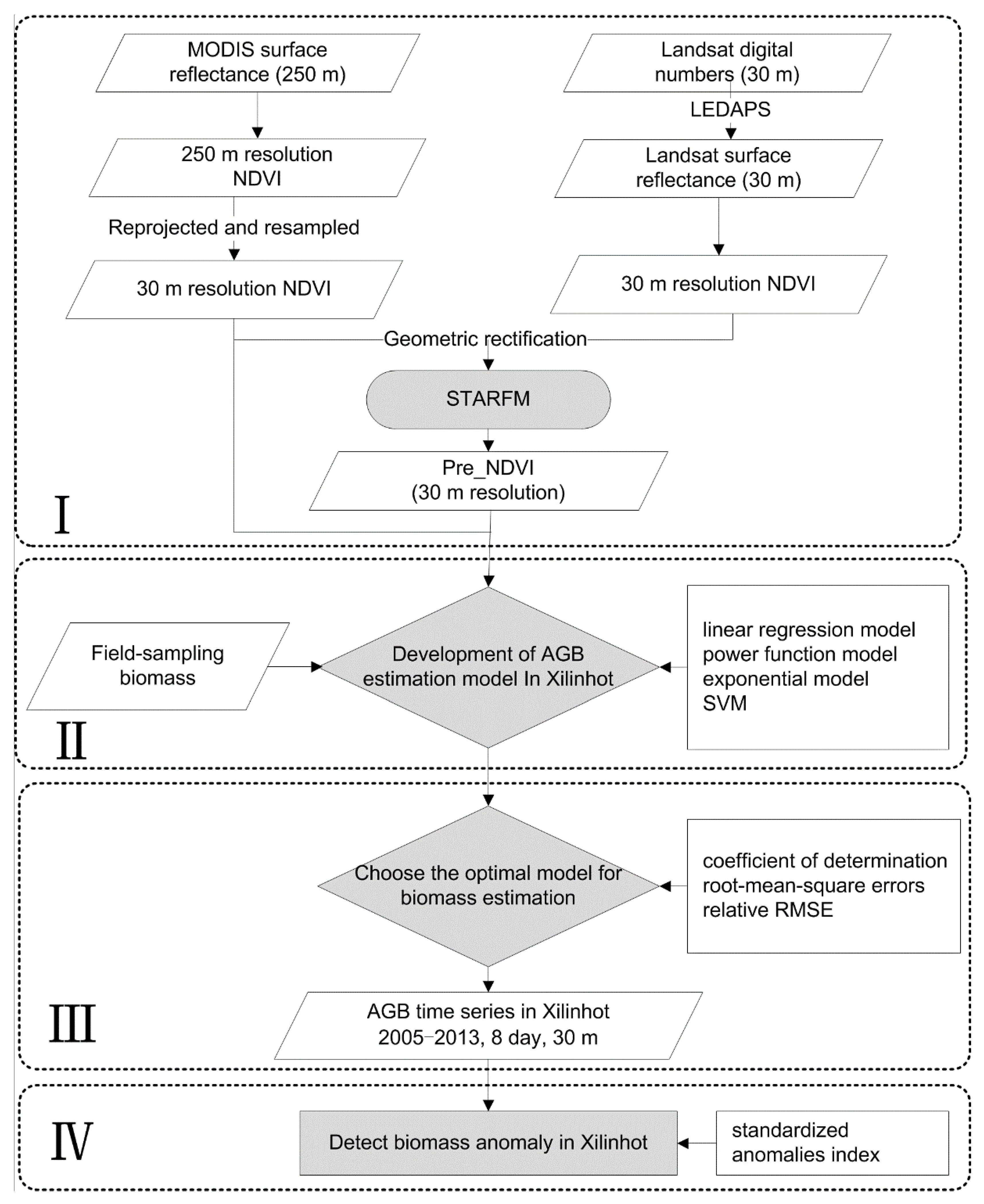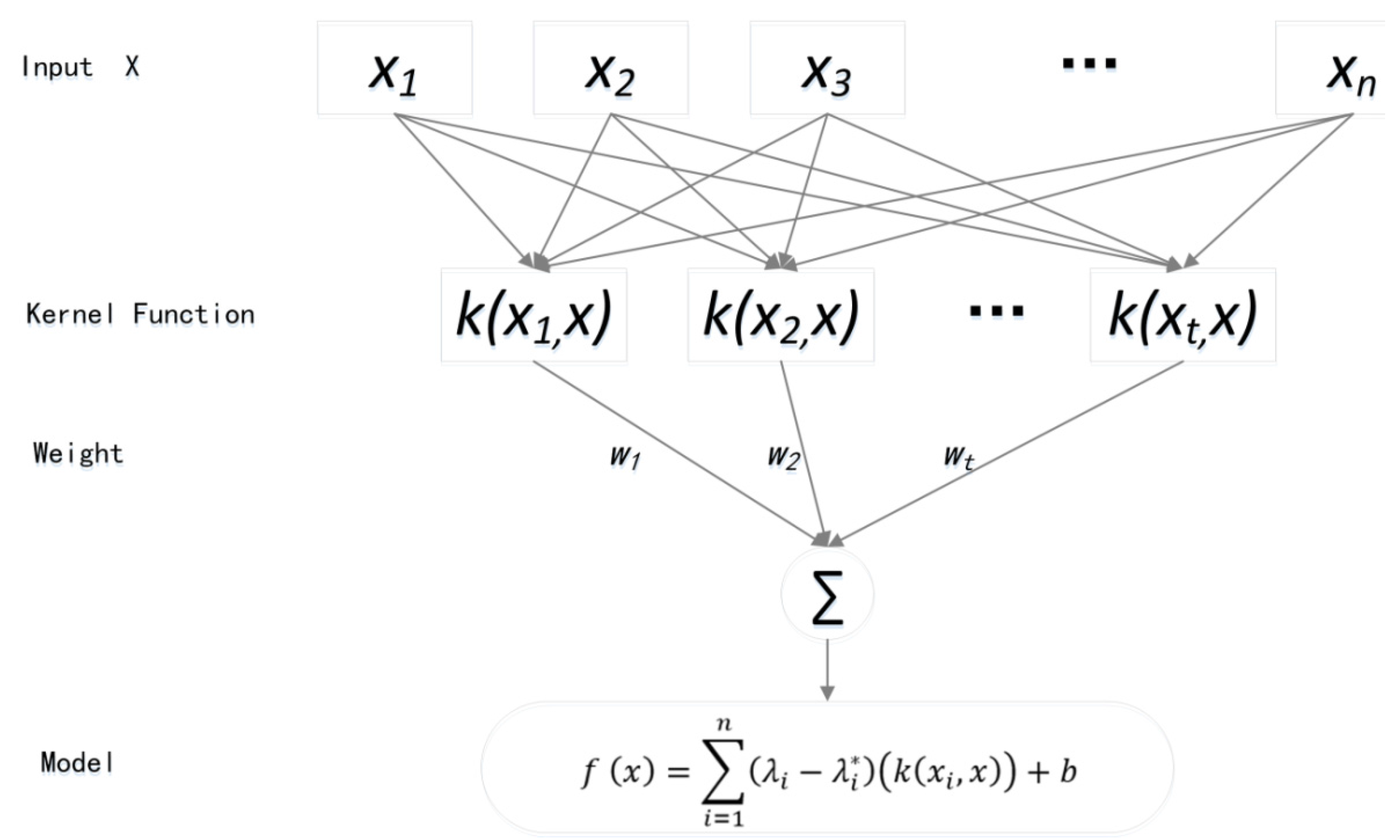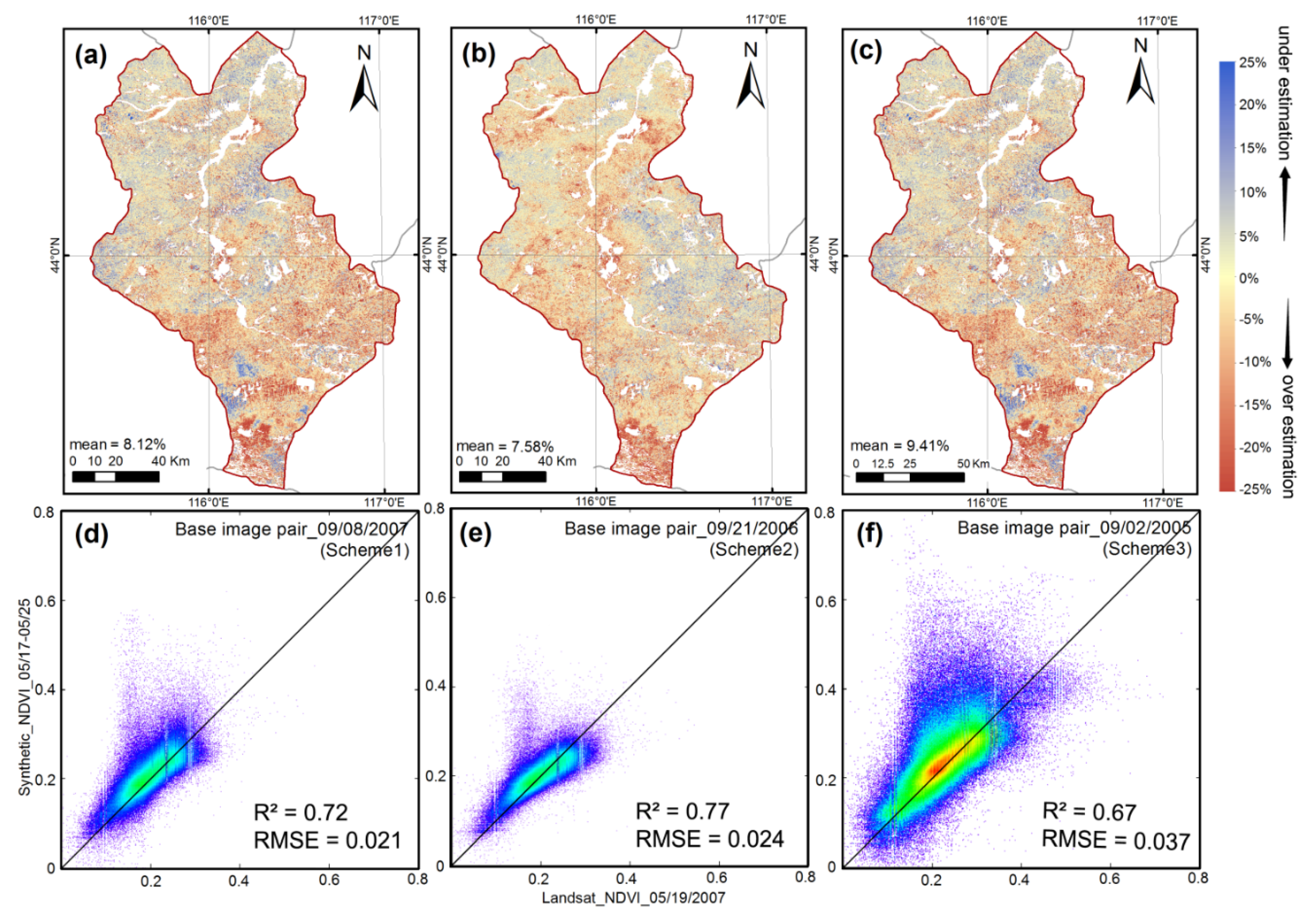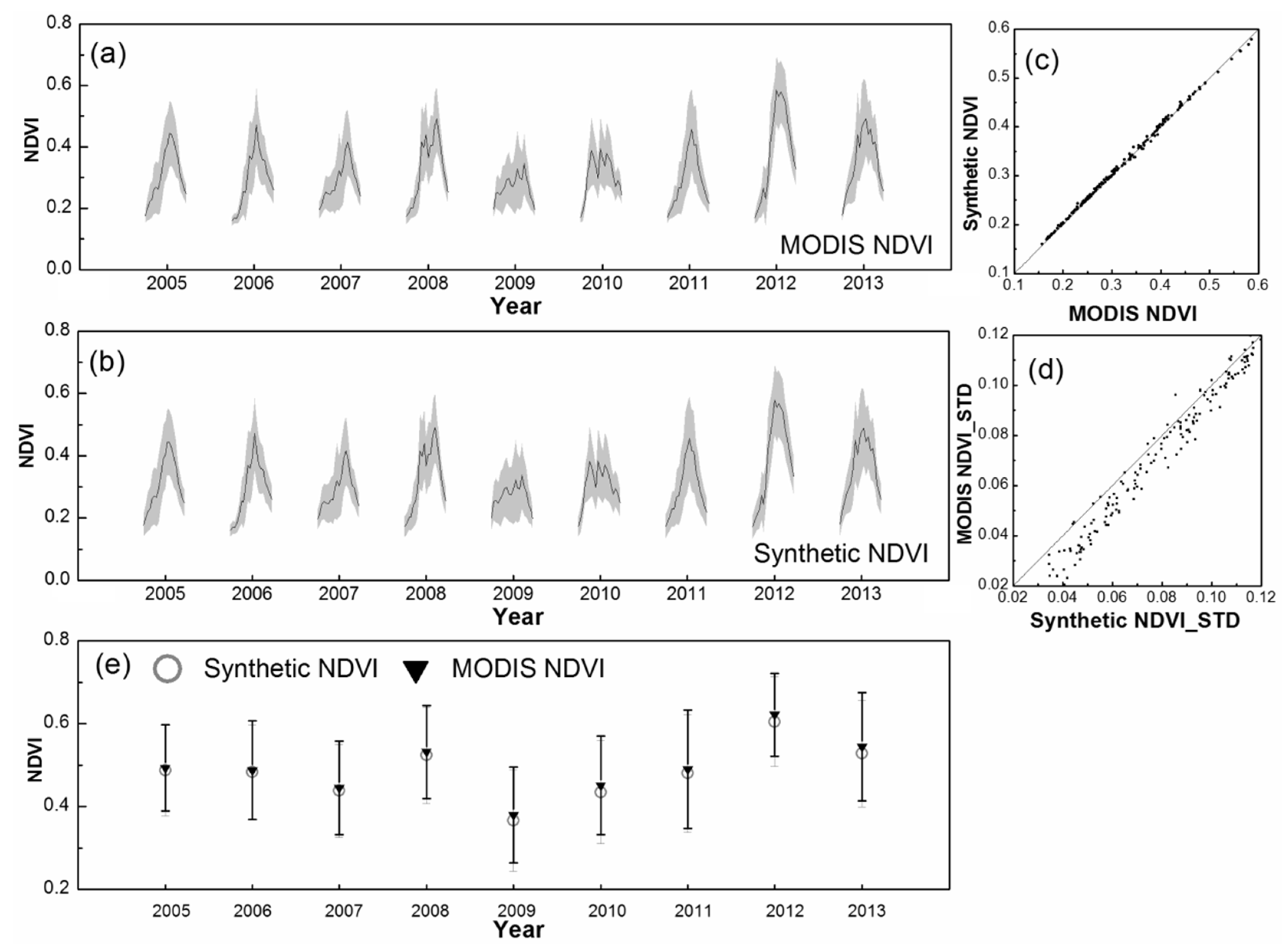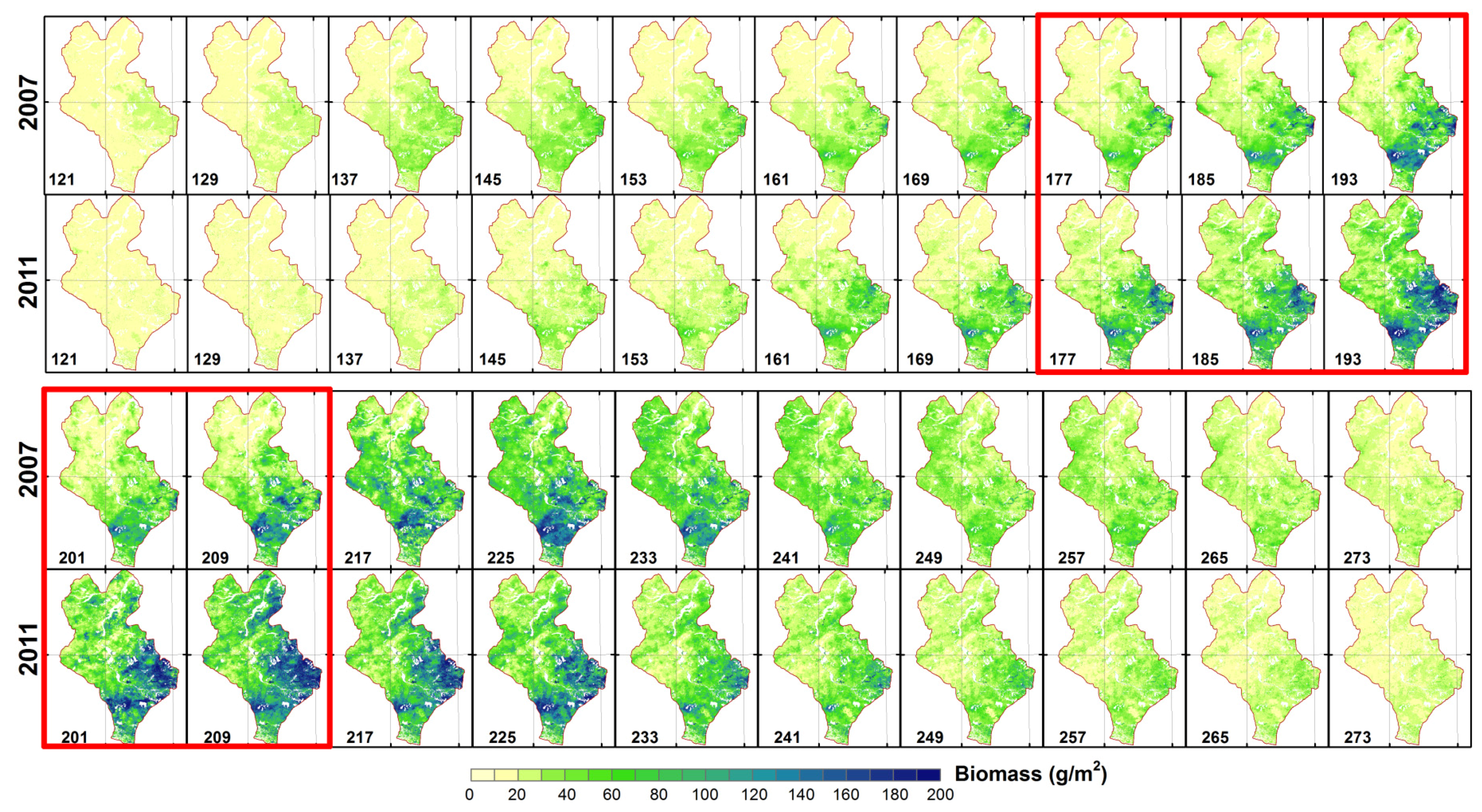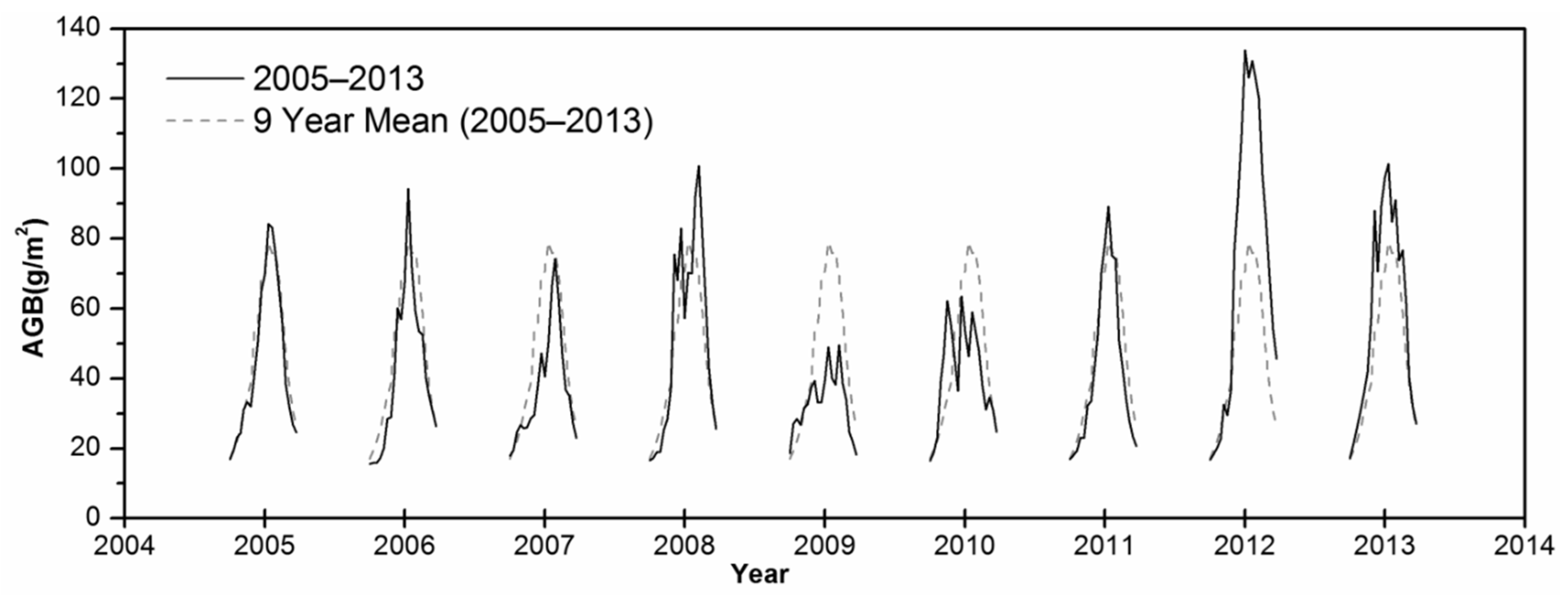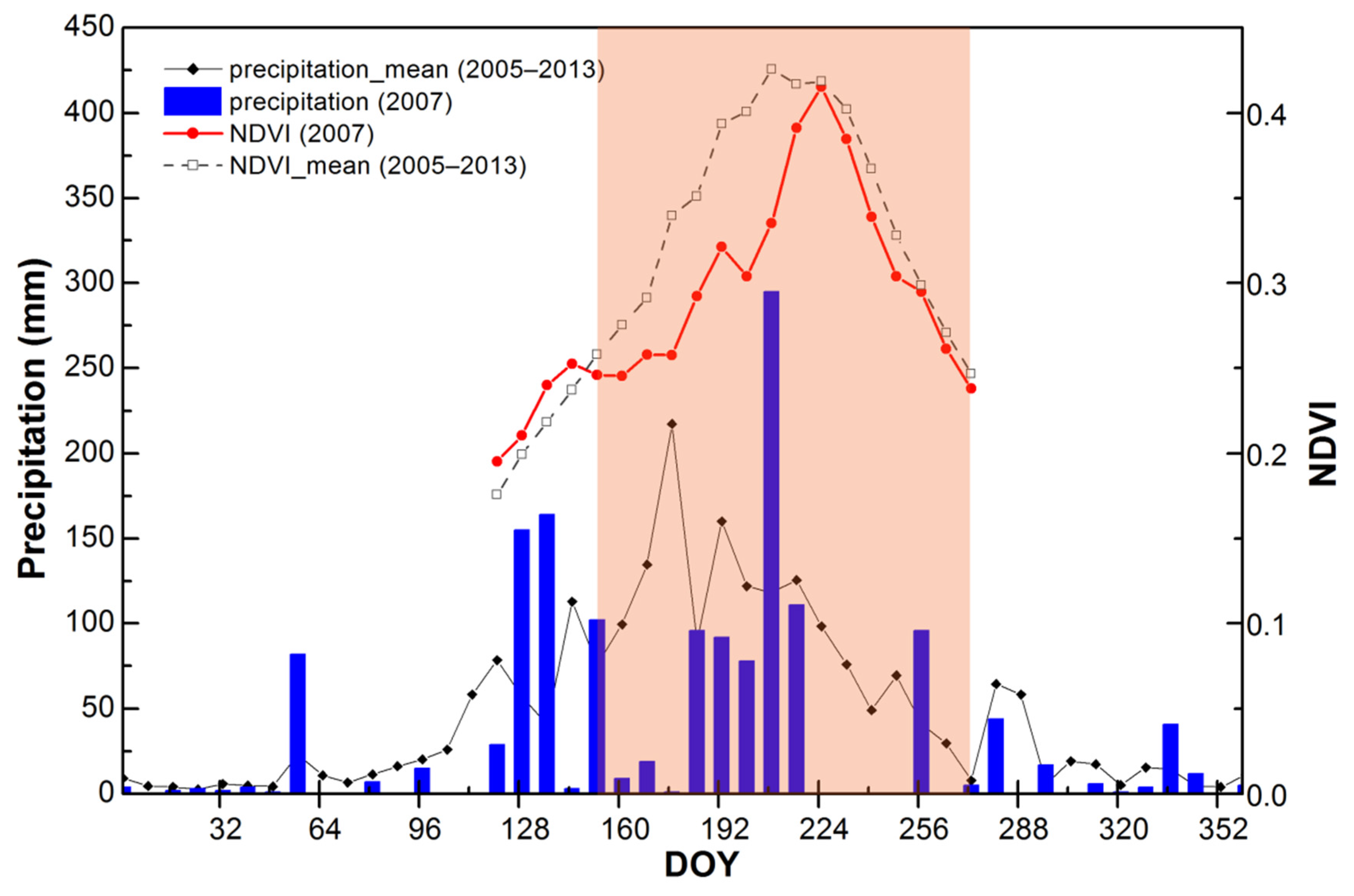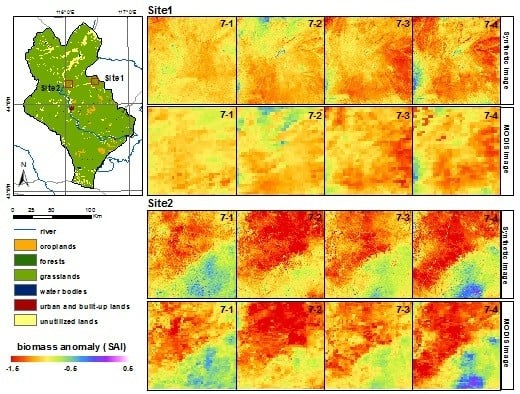4.1. Accuracy Assessment of Synthetic NDVI Based on STARFM
Figure 4 shows the validation results for the three fusion schemes described in
Section 3.2, that is, data fusion within one year (
Figure 4a,d) (2007), with adjacent years (
Figure 4b,e) (2007 and 2006), and with 2-yr intervals (
Figure 4c,f) (2007 and 2005). Red colors represent over-estimations and blue colors indicate under-estimations for synthetic NDVI.
Figure 4d–f show the scatter plots between Landsat NDVI and synthetic NDVI for the three schemes. As we only considered grasslands in Xilinhot, all other vegetation types have been masked out.
There was good agreement between the observed Landsat NDVI images and synthetic NDVI data in the three schemes. The average relative errors between observed Landsat NDVI images and synthetic data were below 10% (8.12% for Scheme 1, 7.58% for Scheme 2, and 9.41% for Scheme 3). However, the pixels near lake shores, along riverbanks (mainly in the northern and central parts of the study area), and in other sparsely vegetated areas (mainly in the southern parts of the study area) showed larger differences between synthetic NDVI and NDVI derived from observed TM. The study of Zhang
et al. [
31] also pointed out that over-estimations of synthetic images were mainly located at pixels near riverbanks and lake shores in the mid-eastern parts of New Orleans, USA, and these were due to abrupt surface changes caused by urban flooding [
31]. Cloud contamination can also cause bias between observed NDVI and synthetic NDVI [
16]. Although the MODIS product used in this study give the 8-day optimal observations, it can still not fully remove the atmospheric noise [
56], which could affect the accuracy of the fusion result. While in most of the study area, the grass sceneries were homogenous and the three schemes showed good fusion results. However, the fusion results of Scheme 1 (within one year) and Scheme 2 (with adjacent years) were slightly better than Scheme 3, as they had higher coefficients of determination (
R2) and lower root-mean-square errors (
R2 = 0.72, RMSE = 0.021 for Scheme 1;
R2 = 0.77, RMSE = 0.024 for Scheme 2;
R2 = 0.67, RMSE = 0.037 for Scheme 3) (
Figure 4).
Figure 4.
Difference maps and scatter plots between the observed Landsat NDVI images (taken 19 May 2007) and the synthetic NDVI images (taken during 17–24 May 2007) predicted by (Left) (a,d) Scheme 1; (Middle) (b,e) Scheme 2, and (Right) (c,f) Scheme 3.
Figure 4.
Difference maps and scatter plots between the observed Landsat NDVI images (taken 19 May 2007) and the synthetic NDVI images (taken during 17–24 May 2007) predicted by (Left) (a,d) Scheme 1; (Middle) (b,e) Scheme 2, and (Right) (c,f) Scheme 3.
We further chose five statistical indices (
i.e., mean value, standard deviation, entropy, average gradient, and mean absolute difference) to assess the quality of the predicted synthetic NDVI products (
Table 4). There were no considerable differences between the observed and predicted NDVI images for the three schemes, and the first four indices were nearly identical. The average differences were all below 0.025. In addition, the fused images in the same year (Scheme 1) and in the adjacent years had more consistent results with observed images than those from Scheme 3, as indicated by the five indices. In another woodland area, similar coefficient of determinations (0.66–0.94) between the observed TM NDVI and predicted NDVI were found by Bhandari
et al. [
23]. Overall, our predicted NDVI images were fairly reliable and could be used for accurate estimations of AGB. In the following work, we chose different data-fusion schemes according to the availability of TM images.
Table 4.
Accuracy assessment of the fused images. TM_NDVI is the observed TM NDVI image and Pre_NDVI represents the predicted NDVI images at 30-m resolution that were derived from STARFM with Schemes 1, 2, and 3. Numbers in bold represent the best fit among the three schemes.
Table 4.
Accuracy assessment of the fused images. TM_NDVI is the observed TM NDVI image and Pre_NDVI represents the predicted NDVI images at 30-m resolution that were derived from STARFM with Schemes 1, 2, and 3. Numbers in bold represent the best fit among the three schemes.
| Type | Mean | Standard Deviation | Entropy | Average Gradient | Mean Absolute Difference |
|---|
| TM_NDVI | 0.240 | 0.049 | 3.619 | 0.014 | / |
| Pre_NDVI_Scheme1 | 0.244 | 0.053 | 3.653 | 0.013 | 0.019 |
| Pre_NDVI_Scheme2 | 0.245 | 0.045 | 3.566 | 0.012 | 0.018 |
| Pre_NDVI_Scheme3 | 0.247 | 0.060 | 3.725 | 0.016 | 0.022 |
4.2. Prediction of Time-Series Synthetic NDVI
Based on the above analysis of the three fusion schemes, we decided to use data in the same year (except for 2008, 2012, and 2013), in adjacent years (2008, 2012), and data with 2-yr intervals (2013) (data shown in
Table 1) to predict the synthetic NDVI.
We fused TM and MODIS NDVI by using the STARFM method and predicted NDVI for each 8-d intervals during 2005–2013. A total of 180 NDVI scenes (20 scenes/yr for 9 yr) were predicted.
Figure 5a,b show the mean and standard deviation of MODIS NDVI and synthetic NDVI at 8-day intervals during 2005–2013, respectively.
Figure 5c shows the relationship between the MODIS NDVI and synthetic NDVI results that were shown in
Figure 5a,b, respectively.
Figure 5d shows the relationship between the standard deviations of the MODIS NDVI and synthetic NDVI results that were shown in
Figure 5a,b, respectively.
Figure 5e shows the maximum NDVI values of MODIS and synthetic images during the growing seasons, which represent the highest vegetation productivity within a year.
Figure 5.
Temporal variations of the regional mean and standard deviation (shaded area) of NDVI for grasslands in the study areas during 2005–2013 (growing season). (a) MODIS NDVI; (b) synthetic NDVI; (c) scatter plots between MODIS NDVI and synthetic NDVI at 8-d intervals; (d) scatter plots between the standard deviation of MODIS NDVI and synthetic NDVI at 8-d intervals; (e) MODIS NDVImax (black) and synthetic NDVImax (gray). Error bars represent the standard deviations of MODIS NDVImax (black) and synthetic NDVImax (gray).
Figure 5.
Temporal variations of the regional mean and standard deviation (shaded area) of NDVI for grasslands in the study areas during 2005–2013 (growing season). (a) MODIS NDVI; (b) synthetic NDVI; (c) scatter plots between MODIS NDVI and synthetic NDVI at 8-d intervals; (d) scatter plots between the standard deviation of MODIS NDVI and synthetic NDVI at 8-d intervals; (e) MODIS NDVImax (black) and synthetic NDVImax (gray). Error bars represent the standard deviations of MODIS NDVImax (black) and synthetic NDVImax (gray).
The means of the synthetic NDVI values were almost identical to those of the MODIS NDVI (
Figure 5c). The predicted NDVI (30 m) therefore retained the high-frequency temporal information from the MODIS NDVI time series. The predicted images had larger standard deviations and represent larger dispersions of the imagery (
Figure 5d), which indicates that the synthetic images may contain more detailed information. The differences between the standard deviation of MODIS NDVI and synthetic NDVI in this study were less than those reported in the study of Tian
et al. [
18]. In their study, these differences could be clearly observed in graphics similar to the ones in
Figure 5a,b, and the shadow area of the synthetic NDVI series was much larger than the MODIS NDVI series. This can be explained by the homogeneous landscape for grasslands in Xilinhot, our study area. In contrast, in the study of Tian
et al. [
18], the study area was a mixed fragmentized landscape consisting of forests, shrublands, and residential areas.
Our results indicate that the accuracy of time-series NDVI derived from the STARFM algorithm was reliable and that the STARFM could effectively predict NDVI time series at higher spatial and temporal resolutions for the grasslands. The synthetic NDVI time series described more detailed spatial variations of NDVI at a resolution of 30 m. The temporal information from MODIS and the spatial information from Landsat were integrated in the predicted synthetic NDVI data set, and it was expected that such data can provide superior input for accurate estimations of AGB time series.
4.3. Development of the AGB Estimation Model
We developed four regression models for estimating the AGB, and these included linear regression model, power function model, exponential model, and support vector machine model (SVM-AGB). We randomly selected 46 biomass field samples and the corresponding synthetic NDVI pixels as the training set to construct the four models. We then used the other 22 samples to assess the accuracy of the four models. The accuracy assessment results indicated that for both MODIS NDVI and synthetic NDVI, the SVM-AGB model had higher accuracy than the other three models (
Table 5 and
Table 6). We further compared the synthetic NDVI-derived SVM-AGB model and MODIS NDVI-derived SVM-AGB model and found that the accuracies of the synthetic NDVI-derived SVM-AGB model data were higher than the accuracies of MODIS NDVI-derived SVM-AGB model data, as indicated by the
R2, RMSE, and RMSE
r for both the training set and testing set (
Table 5 and
Table 6). Therefore, we finally chose to integrate the SVM-AGB model and the synthetic NDVI to predict AGB for grasslands in Xilinhot during 2005–2013.
We compared our SVM-AGB model (
R2 = 0.77, RMSE = 17.22 g/m
2, RMSE
r = 24.8%) with other AGB estimation models in the same region, e.g., the exponential model based on 250-m MODIS NDVI (
R2 = 0.447) by Kawamura
et al. [
57]; the ANN model based on elevation, Landsat NDVI, and Landsat reflectance data (
R2 = 0.82, RMSE = 60.01 g/m
2, RMSE
r = 40.61%) by Xie
et al. [
35]; and the power function model based on 250-m MODIS NDVI (
R2 = 0.568, RMSE = 673.88 kg/ha) by Jin
et al. [
47]. The studies by Kawamura
et al. [
57] and Jin
et al. [
47] mainly used 250-m MODIS NDVI data, and the accuracies of their models were lower than that of our estimation model (
R2 = 0.447 by Kawamura
et al.;
R2 = 0.568 by Jin
et al.;
R2 = 0.77 by our synthetic NDVI-derived SVM-AGB model). Meanwhile, in the study of Xie
et al. [
35], although their ANN model was built on Landsat NDVI and reflectance images and possessed higher accuracy, the limitations of sparse temporal data associated with Landsat images restricted their model’s application to the requirements of frequent time series and dynamic monitoring. In general, our synthetic NDVI-derived SVM-AGB estimation model had both higher spatial resolutions (30 m) and temporal resolutions (8 d) than the other models in
Table 5 and
Table 6 and showed improvements compared to other AGB estimation models generated from a single type of remotely sensed data [
33,
35,
47,
56].
Table 5.
Comparison of the accuracy of different AGB estimation models based on synthetic NDVI data.
Table 5.
Comparison of the accuracy of different AGB estimation models based on synthetic NDVI data.
| AGB Model | Regression Equation | Training Set | Testing Set |
|---|
| R2 | RMSE | RMSEr | R2 | RMSE | RMSEr |
|---|
| (g/m2) | (g/m2) |
|---|
| Linear regression model | | 0.71 | 31.40 | 42.6% | 0.79 | 26.48 | 34.6% |
| Power function model | | 0.68 | 33.62 | 44.6% | 0.84 | 28.03 | 38.0% |
| Exponential model | | 0.67 | 34.14 | 45.1% | 0.84 | 28.60 | 38.8% |
| SVM-AGB | / | 0.77 | 17.22 | 24.8% | 0.83 | 22.60 | 31.3% |
Table 6.
Comparison of the accuracy of different AGB estimation models based on MODIS NDVI.
Table 6.
Comparison of the accuracy of different AGB estimation models based on MODIS NDVI.
| AGB Model | Regression Equation | Training Set | Testing Set |
|---|
| R2 | RMSE | RMSEr | R2 | RMSE | RMSEr |
|---|
| (g/m2) | (g/m2) |
|---|
| Linear regression model | | 0.66 | 34.13 | 46.3% | 0.64 | 34.19 | 42.1% |
| Power function model | | 0.68 | 33.21 | 44.8% | 0.69 | 31.23 | 40.9% |
| Exponential model | | 0.68 | 33.36 | 44.9% | 0.69 | 31.24 | 41.1% |
| SVM-AGB | / | 0.73 | 30.61 | 43.0% | 0.72 | 22.89 | 37.1% |
4.4. Drought Condition Monitoring with Time-Series Biomass Maps
We further used all the 68 biomass field samples and the corresponding synthetic NDVI pixels to generate synthetic NDVI-derived SVM-AGB model. Specifically, we estimated the AGB for the entire grassland area of Xilinhot, Inner Mongolia, for the growing season during 2005–2013.
Figure 6 illustrates the spatial distribution of biomass in 2007 (drought year) and 2011 (non-drought year) for each 8-d intervals during the growing season.
Figure 7 shows the fluctuations of the regional mean biomass in the study areas during 2005–2013. The biomass variation of the regional mean in 2011 was almost identical with the 10-yr mean (
Figure 7), and therefore, biomass maps in 2011 can be used to represent the general vegetation growth conditions in Xilinhot.
Generally, biomass for May–September exhibited large spatial heterogeneity, which is of great significance for detecting grassland conditions. The AGB generally showed a decreasing trend from the southeast to the northwest. In 2011, in the first week of May (day of year (DOY): 121), the grassland biomass was generally below 20 g/m2 and the regional mean was 16.9 g/m2. During July, nearly half of the grassland biomass values reached 40–50 g/m2. Grassland biomass reached its peak values during the end of July and the start of August. In the last week of July (DOY: 209), the highest value reached to 190 g/m2 in the southeast region, while in the northwest region, the biomass was as low as 35 g/m2. Then, biomass started to decrease during the third week of August. In the first week of September (DOY: 233), the regional mean AGB was 34.0 g/m2, and it decreased to 26.2 g/m2 during the last week of September.
Figure 6.
Spatial distribution of biomass in 2007 and 2011 for each 8-d intervals during the growing season.
Figure 6.
Spatial distribution of biomass in 2007 and 2011 for each 8-d intervals during the growing season.
Figure 7.
The 8-d intervals of the regional mean biomass estimated based on synthetic NDVI and SVM-AGB model during the growing season (May to September) of 2005–2013 in Xilinhot. Dash line represents the regional mean biomass of 9-yr mean (2005–2013).
Figure 7.
The 8-d intervals of the regional mean biomass estimated based on synthetic NDVI and SVM-AGB model during the growing season (May to September) of 2005–2013 in Xilinhot. Dash line represents the regional mean biomass of 9-yr mean (2005–2013).
Returning to the drought analysis, comparisons of the biomass were made between 2007 (drought year) and 2011 (non-drought year). In 2007, biomass generally exhibited temporal variations similar to the biomass variations in 2011. Importantly, during the end of June to the end of July (DOY: 177–209) (indicated by red rectangles), large areas of biomass in 2007 showed much lower biomass compared with the biomass in 2011 (
Figure 6), especially in the southwestern region of Xilinhot. During the third and fourth week of July (DOY: 201 and 209) in 2007, large areas of biomass in the southwest were below 100 g/m
2, while in 2011, the biomass values reached up to 150 g/m
2. For the remainder of the growing season, no large differences were detected between the biomass maps in 2007 and 2011.
Overall, the time series of biomass during the growing season of 2005–2013 (black line) generally showed similar temporal variations with the 9-yr mean (2005–2013) (dashed line) (
Figure 7). However, biomass in 2007, 2009, and 2010 showed larger negative anomalies compared with the 9-yr means largely because of the droughts in this area.
The year of 2007 was recorded as a drought year [
58], and the biomass values during June and October 2007 were mostly below the multi-year mean (
Figure 7). This was consistent with the findings of Yu
et al. [
59] and Hang
et al. [
60]. Yu
et al. [
61] used the Modified Grassland Index (MGI) to monitor grassland variations in Xilingol (2001–2010) and found that the MGI values in 2007 were much lower than MGI values in other years. In the study of Hang
et al. [
60], the annual and seasonal NDVI in 2007 was below that in other years (2000–2010) in Xilingol. The largest negative biomass anomaly during 2005–2013 was found during the second week of July in 2009 (51.7% less than the 9-yr mean), followed by the second week of August in 2009 (50.0% lower than the 9-yr mean) and the first week of August in 2009 (47.0% lower than the 9-year mean). Jin
et al. [
47] also found that during 2006–2012, the biomass in 2009 was the lowest and it was 31.5% lower than the 7-yr mean in Xilingol League (Xilinhot is located in the center of Xilingol League). This was mainly attributed to severe drought and insect outbreaks in this region in 2009 [
62]. Biomass in 2010 showed large fluctuations. According to the national grassland report in 2010 issued by Farmer’s daily [
59], Xilingol League suffered from severe snow disasters during the end of 2009 and the beginning of 2010. For grasslands in Inner Mongolia, up to 32 million ha of grassland were affected [
59], which could be a possible reason for the biomass fluctuations in 2010. Conversely, biomass in 2012 was much larger than that in other years. In the third week of July, the mean biomass of the study area even reached to 133.86 g/m
2, which was 88.9% higher than the 9-yr mean. Jin
et al. [
47] stated that 2012 was a prime harvest year for all of Xilingol, and the biomass value was 40% higher than the annual average (2005–2013) and twice the value in 2009.
To further explore the capability of the synthetic NDVI for detecting anomalous vegetation activity, we took the biomass during the drought year (2007) as an example and then compared the data to the 9-yr mean (2005–2013) through using
. In 2007, large vegetation anomalies were mainly found during June to the start of August (
Figure 8, DOY: 153–217), which can be attributed to the rainfall shortages. Large water deficiencies were detected during the start of March to the end of June (DOY: 64–176) (
Figure 8). Other studies have found that precipitation has obvious lag effects on vegetation in the study region, and the lag response time is typically 48 to 56 d [
61,
63]. Although precipitation in the last week of July was even more than twice the 9-yr mean, it did not relieve the stress on vegetation during this month. Biomass in the third week of July in 2007 was even 42.7% lower than the multi-year mean (
Figure 8).
Figure 8.
Time series of precipitation and predicted synthetic NDVI (8-d intervals) for Xilinhot in 2007 (precipitation data at site Xilinhot were obtained from the China meteorological data sharing service system).
Figure 8.
Time series of precipitation and predicted synthetic NDVI (8-d intervals) for Xilinhot in 2007 (precipitation data at site Xilinhot were obtained from the China meteorological data sharing service system).
Figure 9 shows the biomass anomalies in 2007 compared with the mean of 2005–2013 during July. Site 1 was located at the Maodeng Ranch, which is China’s largest typical-steppe reserve [
48]. Site 2 was occupied by lovely achnatherum, needlegrass, and little-leaf pea shrub [
48]. The distribution of the biomass anomalies based on MODIS NDVI-derived biomass and synthetic NDVI-derived biomass data generally showed good agreement. However, the biomass derived from the synthetic NDVI image data showed more details compared with MODIS NDVI-derived biomass data. Terrain textures and roads can be clearly identified in the maps from the synthetic images. In addition, the absolute SAI of biomass maps from the synthetic NDVI images was generally larger than that of the MODIS NDVI-derived biomass images, which implies that the synthetic images can better capture the biomass anomalies than MODIS NDVI-derived biomass images.
Figure 9.
The Standardized Anomalies Index (SAI) indicating biomass anomalies in Xilinhot during July 2007. The land cover map in Xilinhot in the left panel was adapted from the land cover data set provided by the Data Center for Resources and Environmental Sciences, Chinese Academy of Sciences (
http://www.resdc.cn). The unutilized lands represent lands that have not been used (including desert, Gobi region, saline, wetlands, bare soil).
Figure 9.
The Standardized Anomalies Index (SAI) indicating biomass anomalies in Xilinhot during July 2007. The land cover map in Xilinhot in the left panel was adapted from the land cover data set provided by the Data Center for Resources and Environmental Sciences, Chinese Academy of Sciences (
http://www.resdc.cn). The unutilized lands represent lands that have not been used (including desert, Gobi region, saline, wetlands, bare soil).
